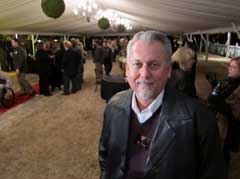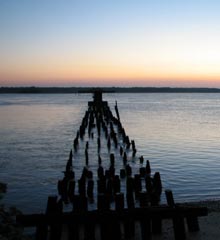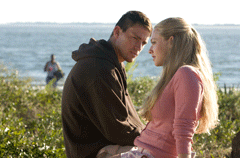Professional photographer Eric Horan sheds some light on gearing up for the perfect shot and why he prefers his in the RAW.

“It’s not the camera. It’s what you do with it, what you put in front of the viewfinder.”
– Eric Horan
Mark Shaffer: We live in one of the most photographed towns on the east coast. So for all the amateur photographers wandering around the Lowcountry snapping away at the wildlife and the scenery, what’s the key to taking good pictures?
 Eric Horan: That’s a wide open question with a lot of variables – the type of camera, the lighting. A lot of people aren’t going to bother to learn a lot about their camera and just leave it on “auto.” So the best thing for them is to learn about composition – composition and lighting – because they’re going to rely on the camera to figure out all the exposure stuff. Then they’re going to go out when the light is better and if they know something about composition they’ll benefit from that.
Eric Horan: That’s a wide open question with a lot of variables – the type of camera, the lighting. A lot of people aren’t going to bother to learn a lot about their camera and just leave it on “auto.” So the best thing for them is to learn about composition – composition and lighting – because they’re going to rely on the camera to figure out all the exposure stuff. Then they’re going to go out when the light is better and if they know something about composition they’ll benefit from that.
Besides lighting and composition there’s exposure. When you tackle exposure you’re tackling the nuts, bolts and the guts of photography – F-stops and shutter speed and how to override your smart camera – which is smart about 90 percent of the time and messes you up the other 10 percent.
MS: I find that I rely on the automatic functions too much.
EH: As far as exposure, the cameras are pretty smart. If you’re shooting landscapes the camera knows that you need enough depth of field to deal with it. But you can’t alter the process if you don’t know anything about it.
For people who want to learn how to have a bit more control over how their pictures come out, learning F-stops and shutter speeds and the relationship between those two is important. Even if you don’t shoot in Manual, learn to shoot in Aperture Priority mode or Shutter Priority mode because that way you’re picking what’s important to you. The camera will pick the other value but you know how to alter and adjust that if the camera’s not giving you what you want. If you need a 500th of a second to stop the action and the camera’s saying “Okay, let’s shoot F8/500” but you would rather shoot F11 because it’s over-exposed, you need to learn how to use the Exposure Compensation button. Quickly with your thumb add “plus one” and shoot what you want. I recommend that everyone learn the auto modes, learn Aperture Priority and Shutter Priority and pick the one you like best.
MS: Which do you prefer?
EH: I shoot Aperture Priority. I’ve been doing it so long I know what the shutter speed’s going to be. That way I don’t have to switch modes. I always shoot in Aperture priority and compensate with the Exposure Compensation Button. There are some situations where I’ll shoot in Manual, but that’s two adjustments while in Auto Mode it’s one adjustment.
MS: When you’re out on the river photographing birds, for instance, how much fiddling with the camera are you actually doing?
EH: Quite a bit. Your camera meter is turning everything into neutral grey. If you have a white bird in a landscape it’s going to be over-exposed. If your meter is seeing just the white bird, it’s going to be underexposed because it’s turning that white bird grey. You have to know those situations. I tell everybody to do test shots before they get into the heat of action. If you get into a situation where you’ve got all this stuff going on and you haven’t figured out your camera functions, you’re not going to get the results you’re after. But if you make the time to do some test shots and do the evaluation with the histogram-
MS: You see, when you start talking histograms that just scares the crap out of your average technologically challenged guy like me.
EH: Well most of these cameras now, you don’t even have to know the histogram. They have clipping indicators for the highlights and the shadows. The camera will flash blue in all highlight areas and red in all the shadow areas to show you what you’re missing as far as pixels. And you can make those up and down adjustments with the Exposure Compensation button based on these flashing things. You don’t really have to know the histogram. It’s just a more accurate way to read it.
MS: It’s all about histograms and pixels, which brings us to software because we’re processing it all on the computer. As a pro you use Photoshop. What about the rest of us?
EH: Adobe makes the best [photography] software and most people don’t need the big expensive edition. Photoshop Elements is about a hundred bucks and Elements is great. It does almost everything you’d ever want. [Photoshop] Lightroom is one step up from Elements at about three hundred bucks and literally does everything that 95 percent of photographers would ever need to do including file management and archiving.
MS: This is beyond the needs of the casual photographer. This is serious technology for real manipulation of the data.
EH: It will do anything you need it to do. And with those programs there’s room to grow as you learn more about your camera and take a more active part in exposures and all that stuff.
MS: I’m a Mac, so one of the programs I’m considering is Apple’s new and improved Aperture III.
EH: Lightroom is a better program. Aperture’s come a long way, but Lightroom was made by photographers for photographers. It’s better than [the full] Photoshop for that reason because Photoshop was created by graphic designers.
MS: There’s also a lot of free stuff out there that’s pretty good and getting better. I still use Picasa (a free download from Google) because of its simplicity – and because I’m processing JPEGs.
EH: It’s good and it’s free. And if you’re going to shoot JPEGs and rely on the camera to do a lot of the work, then something like Picasa’s fine. But as soon as you discover the advantages of shooting RAW, then you’re going to have to graduate.
MS: Simply put, JPEGs are normal digital images processed by the camera. A RAW image is exactly that: raw data.
EH: It’s kind of like a negative and very few photographers could read negatives – the colors are weird, images are reversed. Your camera is taking a RAW file and making a JPEG based on whatever technology the camera manufacturer uses. So the camera is giving you its best shot for a processed RAW file. Once it’s processed that JPEG file you can’t go back to RAW. In RAW you might have a 20 meg file and the camera’s giving you a 9 meg JPEG. You can never get those 11 megs back. All that information is thrown out. So if the picture doesn’t have the correct exposure or color balance, that information’s just gone. RAW gives you the ability to get all that stuff right in the processing. There’s a lot more latitude in what you can get out of a RAW file. With JPEG you’re stuck with whatever the camera’s giving you.
MS: But JPEG is still the mainstream format because it’s simpler, eats up less memory and doesn’t require special software?
EH: RAW is more work. There’s more of a learning curve. When you start shooting RAW you have to know how to read a histogram, you have to know how to do the processing. It opens up a whole new can of worms.
MS: For those of us who remember the darkroom, sometimes it still seems fantastic that just about anyone can explore photography as long as you have a camera and a computer.
EH: I think that’s why the camera clubs are going crazy – they’ve quadrupled membership in the last few years. I think a lot of people who shot film are turning to digital and a lot of new people are getting into it because of the digital stuff and how smart the cameras are. It’s hurt the professional market, too, because the cameras are so smart and anybody can go out and get a decent shot with a good camera.
MS: Sure, but 99 percent of them aren’t going to go out and do what you do.
EH: No, probably not.
MS: The average Joe’s not going out with a 500mm lens-
EH: And stand on a ladder in a boat –
MS: Not likely. So let’s talk hardware. These days buying a camera is a little like buying a car – new models come out every year, the technology changes so fast – things are practically obsolete out of the box.
EH: If you buy as top-of-the-line as you can it’s going to last longer than an entry-level camera. Spend as much as you can afford. For instance if you’re looking at Canon, you can still get the 40D but it’s going to be a paperweight in two years. If you get the 7D it’s probably good for ten years. As far as lenses go, that depends on what you want to do, what you’re willing to carry and what you can afford.
MS: The last time I was in Zion National Park I watched a pretty funny exchange between a pro photographer and a well-financed amateur. They were both schlepping around a ton of gear, but the amateur had better gear than the pro and more of it.
EH: You wouldn’t believe some of the people who get on my boat. They have so much gear it’s unbelievable and I’m like, “can I borrow that?”
(Laughter)
They’ve got stuff that’s been on my “wish list” for years. And there again, they usually only need a small fraction of that stuff in the boat because you’re limited to what you can do.
MS: I wouldn’t think swapping out lenses every five minutes is a good thing to do in a salt breeze.
EH: (Laughs) No. When I teach nature photography I always tell people they’ve got to pay attention to what’s going on in the field.
MS: Operating the camera needs to be second nature.
EH: To a degree. If you’re still trying to figure out F-stops and shutter speed when you should be shooting, you’re going to miss a lot. And believe me, my list of things to shoot is a lot longer than the list of things I’ve been able to shoot. People ask, “What’s your favorite image?” And I always say it’s one I haven’t shot yet, for sure.
(Laughter)
Eric Horan Photography, Inc.
PO Box 456, Beaufort, SC 29901
843-524-3037
843-524-1638 (fax)
www.horanphoto.com (commercial)
www.southernlight.biz (nature/stock)







